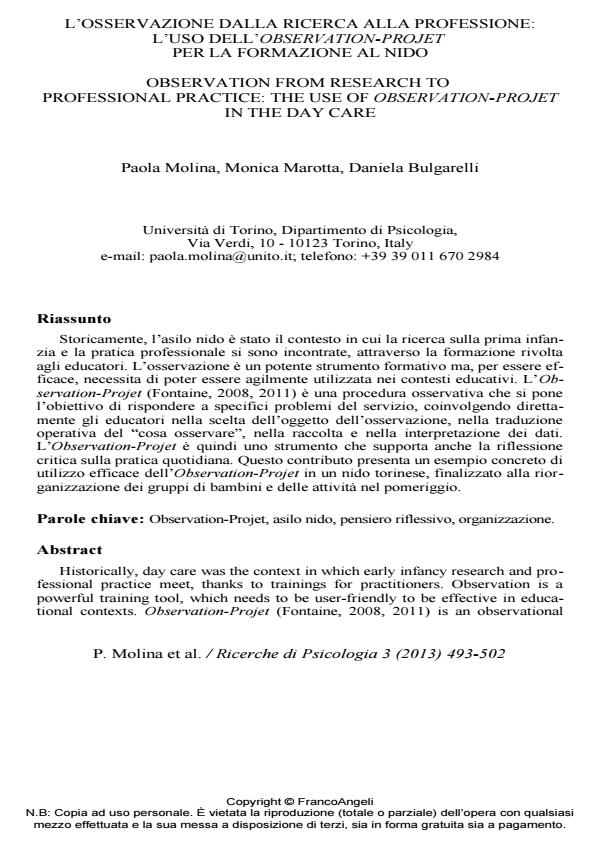Observation from research to professional practice: the use of observation-projet in the day care
Journal title RICERCHE DI PSICOLOGIA
Author/s Paola Molina, Monica Marotta, Daniela Bulgarelli
Publishing Year 2014 Issue 2013/3
Language Italian Pages 10 P. 493-502 File size 196 KB
DOI 10.3280/RIP2013-003006
DOI is like a bar code for intellectual property: to have more infomation
click here
Below, you can see the article first page
If you want to buy this article in PDF format, you can do it, following the instructions to buy download credits

FrancoAngeli is member of Publishers International Linking Association, Inc (PILA), a not-for-profit association which run the CrossRef service enabling links to and from online scholarly content.
Historically, day care was the context in which early infancy research and professional practice meet, thanks to trainings for practitioners. Observation is a powerful training tool, which needs to be user-friendly to be effective in educational contexts. Observation-Projet (Fontaine, 2008, 2011) is an observational procedure that aims to solve specific problems in everyday practice, directly involving practitioners in choosing the observation object, in operationally translating this object, in collecting and interpreting the data. Thus, Observation-Projet could also support professionals in critically reflecting upon their everyday practice. This paper presents a concrete example of effective use of Observation-Projet in an Italian day care, with the aim of reorganizing children’s groups and activities during the afternoon.
Keywords: Observation-Projet, creche, critical thinking, organization.
- Appel, G., & David, M. (2008). Loczy ou le maternage insolite. Raimonville St. Agnes (F): Eres Edition.
- Bondioli, A., & Mantovani, S. (1987). Manuale critico dell'asilo nido. Milano (I): FrancoAngeli.
- Bronfenbrenner, U. (1979). The ecology of human development: Experiments by design and nature. Cambridge, MA: Harvard University Press.
- Campos-de-Carvalho, M.I., & Rossetti-Ferreira, M.C. (1993). Importance of spatial arrangements for young children in day care centers. Children’s Environments, 10(1), 19-30.
- Cohen, D.H., Stern, V., & Balaban, N. (1997). Observing and recording the behavior of young children. New York (N.J.) - London (UK): Teachers College, Columbia University.
- Dalli, C. (2008). Pedagogy, knowledge and collaboration: towards a ground-up perspective on professionalism. European Early Childhood Education Research Journal, 16(2), 171-185. DOI: 10.1080/13502930802141600
- Fontaine, A.M. (2008). Observer en équipe dans les lieux d’accueil de la petite enfance. Développer l’observation-projet. Raimonville St. Agnes (F): Eres Edition.
- Fontaine, A.M. (2011). L’observation professionnelle des jeune enfants. Un travail d’équipe. Savigny-sur-Orge (F): Edition Philippe Duval.
- Goldschmied, E. (1986). Il Bambino nell'asilo nido: guida per le educatrici e i genitori. Milano (I): Fabbri.
- Goldschmied, E. (1994). Persone da 0 a 3 anni, crescere e lavorare nell’ambiente nido. Bergamo (I): Junior.
- Legendre, A. (2001). Influence des caracteristiques de l’environnement sur les reactions bio-emotionnelles de jeunes enfants en creche. In B. Ongari (Ed.), Contextes du développement et facteurs de protection. Actes du XIXème Colloque du GROFRED, (pp. 19-38). Trento, I: Edizioni Jounior.
- Legendre, A., & Fontaine, A.M. (1991). The effects of visual boundaries in two year old’s playrooms. Children Environments Quarterly, 8(1), 2-16.
- Michiels-Philippe, M-P. (1984). L’observation. Neuchatel (CH): Delachaux et Niestle.
- Marotta, M., Bertotto, F., & Molina, P. (2010, March). La formazione delle educatrici del nido all’utilizzo dell’Observation-Projet. Paper presented at the XVII Convegno Nazionale Servizi Educativi per l'Infanzia: I diritti delle bambine e dei bambini of Gruppo Nazionale Nidi Infanzia, Torino, (I).
- Molina, P. (1992). Il valore educativo dei momenti di routine. Bambini, 8(10), 38-43.
- Molina, P. (2012). Progettare e sperimentare strumenti di lavoro per gli educatori. In B. Ongari & F. Tomasi (Eds.), Nido d’infanzia 5. Prospettive di ricerca e spunti per la formazione (pp. 66-80). Trento (I): Erickson.
- Molina, P., Marotta, M., & Bulgarelli, D. (2011). L'osservazione-progetto: uno strumento pratico di lavoro per gli educatori. Psicologia e Scuola, 14, 49-57.
- Molina, P., Marotta, M., & Bulgarelli, D. (in press). The Observation Projet: a professional tool for caregivers. Two experiences in Italian day cares. European Early Childhood Education Research Journal.
- Musatti, T., & Mayer, S. (2011). Sharing attention and activities among toddlers: the spatial dimension of the setting and the educator’s role. European Early Childhood Education Research Journal, 19(2), 207-221. DOI: 10.1080/1350293X.2011.574408
- Schon, D.A. (1983). Educating the reflective practitioner: Toward a new design for teaching and learning in the professions. San Francisco: Jossey-Bass.
- Szanto, A. (in stampa). Il bambino vive, l’adulto riflette. Trento: Erickson
- Varin, D. (1985). Ecologia psicologica e organizzazione dell'ambiente nella scuola materna. Milano (I): FrancoAngeli.
- L'utilizzo dell'osservazione al nido come strumento di riflessione sulle proprie pratiche di lavoro Paola Molina, in RICERCHE DI PSICOLOGIA 3/2016 pp.413
DOI: 10.3280/RIP2016-003010
Paola Molina, Monica Marotta, Daniela Bulgarelli, L’osservazione dalla ricerca alla professione: l’uso dell’observation-projet per la formazione al nido in "RICERCHE DI PSICOLOGIA " 3/2013, pp 493-502, DOI: 10.3280/RIP2013-003006